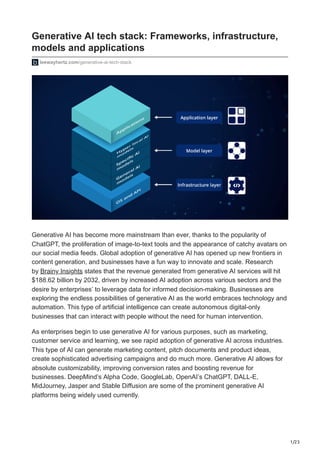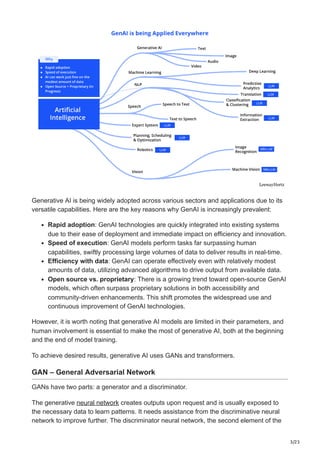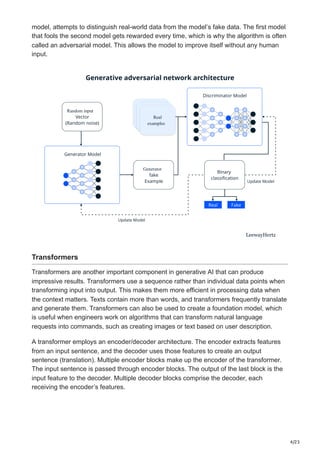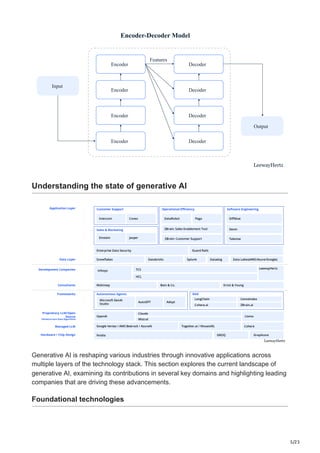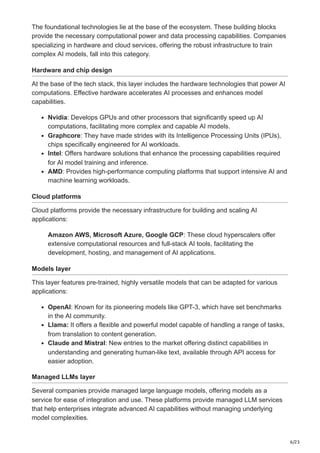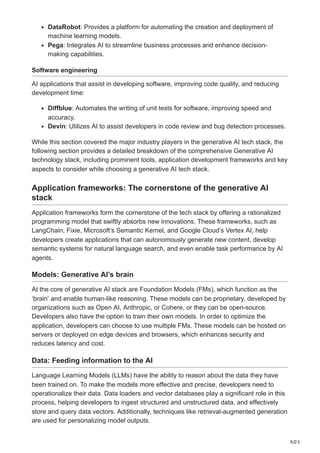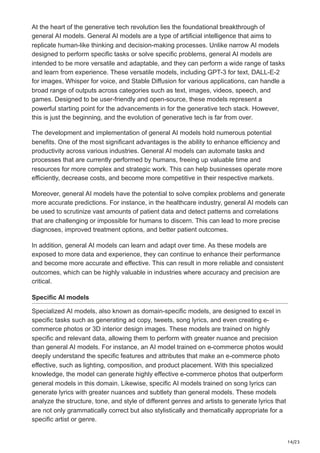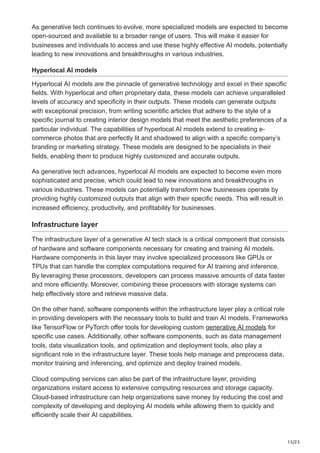leewayhertz.com-Generative AI tech stack Frameworks infrastructure models and applications.pdf
- 1. 1/23 Generative AI tech stack: Frameworks, infrastructure, models and applications leewayhertz.com/generative-ai-tech-stack Generative AI has become more mainstream than ever, thanks to the popularity of ChatGPT, the proliferation of image-to-text tools and the appearance of catchy avatars on our social media feeds. Global adoption of generative AI has opened up new frontiers in content generation, and businesses have a fun way to innovate and scale. Research by Brainy Insights states that the revenue generated from generative AI services will hit $188.62 billion by 2032, driven by increased AI adoption across various sectors and the desire by enterprises’ to leverage data for informed decision-making. Businesses are exploring the endless possibilities of generative AI as the world embraces technology and automation. This type of artificial intelligence can create autonomous digital-only businesses that can interact with people without the need for human intervention. As enterprises begin to use generative AI for various purposes, such as marketing, customer service and learning, we see rapid adoption of generative AI across industries. This type of AI can generate marketing content, pitch documents and product ideas, create sophisticated advertising campaigns and do much more. Generative AI allows for absolute customizability, improving conversion rates and boosting revenue for businesses. DeepMind’s Alpha Code, GoogleLab, OpenAI’s ChatGPT, DALL-E, MidJourney, Jasper and Stable Diffusion are some of the prominent generative AI platforms being widely used currently.
- 2. 2/23 This technology has many use cases, including business and customer applications, customer management systems, digital healthcare, automated software engineering and customer management systems. It is worth noting, however, that this type of AI technology constantly evolves, indicating endless opportunities for autonomous enterprises. This article will take a deep dive into the generative AI tech stack to provide readers with an insider’s perspective on the working of generative AI. What is generative AI? Understanding the state of generative AI Application frameworks: The cornerstone of the generative AI stack Why is a comprehensive tech stack essential in building effective generative AI systems? A detailed overview of the generative AI tech stack Generative AI application development framework for enterprises Things to consider while choosing a generative AI tech stack What is generative AI? Generative AI is a type of artificial intelligence that can produce new data, images, text, or music resembling the dataset it was trained on. This is achieved through “generative modelling,” which utilizes statistical algorithms to learn the patterns and relationships within the dataset and leverage this knowledge to generate new data. Generative AI’s capabilities go far beyond creating fun mobile apps and avatars. They are used to create art pieces, design, code, blog posts and all types of high-quality content. Generative AI uses semi-supervised and unsupervised learning algorithms to process large amounts of data to create outputs. Using large language models, computer programs in generative AI understand the text and create new content. The neural network, the heart of generative AI, detects the characteristics of specific images or text and then applies them when necessary. Computer programs can use generative AI to predict patterns and produce the corresponding content. The following image depicts the rapid advancements in Generative AI across multiple modalities, showcasing the extensive versatility of these technologies. LLMs are playing a pivotal role, from text and speech to more complex systems like expert and robotics applications. These models enhance tasks such as predictive analytics, translation, and even planning and scheduling, demonstrating AI’s capability to adapt and excel across various industries.
- 3. 3/23 Generative AI is being widely adopted across various sectors and applications due to its versatile capabilities. Here are the key reasons why GenAI is increasingly prevalent: Rapid adoption: GenAI technologies are quickly integrated into existing systems due to their ease of deployment and immediate impact on efficiency and innovation. Speed of execution: GenAI models perform tasks far surpassing human capabilities, swiftly processing large volumes of data to deliver results in real-time. Efficiency with data: GenAI can operate effectively even with relatively modest amounts of data, utilizing advanced algorithms to drive output from available data. Open source vs. proprietary: There is a growing trend toward open-source GenAI models, which often surpass proprietary solutions in both accessibility and community-driven enhancements. This shift promotes the widespread use and continuous improvement of GenAI technologies. However, it is worth noting that generative AI models are limited in their parameters, and human involvement is essential to make the most of generative AI, both at the beginning and the end of model training. To achieve desired results, generative AI uses GANs and transformers. GAN – General Adversarial Network GANs have two parts: a generator and a discriminator. The generative neural network creates outputs upon request and is usually exposed to the necessary data to learn patterns. It needs assistance from the discriminative neural network to improve further. The discriminator neural network, the second element of the
- 4. 4/23 model, attempts to distinguish real-world data from the model’s fake data. The first model that fools the second model gets rewarded every time, which is why the algorithm is often called an adversarial model. This allows the model to improve itself without any human input. Generator Random input Real examples Real examples Real examples Transformers Transformers are another important component in generative AI that can produce impressive results. Transformers use a sequence rather than individual data points when transforming input into output. This makes them more efficient in processing data when the context matters. Texts contain more than words, and transformers frequently translate and generate them. Transformers can also be used to create a foundation model, which is useful when engineers work on algorithms that can transform natural language requests into commands, such as creating images or text based on user description. A transformer employs an encoder/decoder architecture. The encoder extracts features from an input sentence, and the decoder uses those features to create an output sentence (translation). Multiple encoder blocks make up the encoder of the transformer. The input sentence is passed through encoder blocks. The output of the last block is the input feature to the decoder. Multiple decoder blocks comprise the decoder, each receiving the encoder’s features.
- 5. 5/23 Encoder-Decoder Model Input Output Encoder Decoder Decoder Decoder Decoder Encoder Encoder Encoder Features LeewayHertz Understanding the state of generative AI Generative AI is reshaping various industries through innovative applications across multiple layers of the technology stack. This section explores the current landscape of generative AI, examining its contributions in several key domains and highlighting leading companies that are driving these advancements. Foundational technologies
- 6. 6/23 The foundational technologies lie at the base of the ecosystem. These building blocks provide the necessary computational power and data processing capabilities. Companies specializing in hardware and cloud services, offering the robust infrastructure to train complex AI models, fall into this category. Hardware and chip design At the base of the tech stack, this layer includes the hardware technologies that power AI computations. Effective hardware accelerates AI processes and enhances model capabilities. Nvidia: Develops GPUs and other processors that significantly speed up AI computations, facilitating more complex and capable AI models. Graphcore: They have made strides with its Intelligence Processing Units (IPUs), chips specifically engineered for AI workloads. Intel: Offers hardware solutions that enhance the processing capabilities required for AI model training and inference. AMD: Provides high-performance computing platforms that support intensive AI and machine learning workloads. Cloud platforms Cloud platforms provide the necessary infrastructure for building and scaling AI applications: Amazon AWS, Microsoft Azure, Google GCP: These cloud hyperscalers offer extensive computational resources and full-stack AI tools, facilitating the development, hosting, and management of AI applications. Models layer This layer features pre-trained, highly versatile models that can be adapted for various applications: OpenAI: Known for its pioneering models like GPT-3, which have set benchmarks in the AI community. Llama: It offers a flexible and powerful model capable of handling a range of tasks, from translation to content generation. Claude and Mistral: New entries to the market offering distinct capabilities in understanding and generating human-like text, available through API access for easier adoption. Managed LLMs layer Several companies provide managed large language models, offering models as a service for ease of integration and use. These platforms provide managed LLM services that help enterprises integrate advanced AI capabilities without managing underlying model complexities.
- 7. 7/23 MosaicML is a fully interoperable, cloud-agnostic, and enterprise-proven platform that enables training large AI models on your data in a secure environment. It offers state-of-the-art MPT large language models (LLMs) and is designed for fast, cost- effective training of deep learning models. Frameworks and proprietary technologies Foundational tools and proprietary systems that support AI functionalities: OpenAI, Google’s Vertex AI, and NVIDIA are innovators in AI research and development. OpenAI is known for its GPT models, Google’s Vertex AI provides a platform for machine learning model development, and NVIDIA offers advanced AI computing platforms. Microsoft GenAI Studio: Popularly known as Azure AI studio, it is designed for building, evaluating, and deploying generative AI solutions and custom copilots, providing comprehensive tools to streamline the creation of AI applications. Llama: Meta’s large language model is designed for a variety of tasks, part of Meta’s initiative to enhance AI research and deployment capabilities. Consultancy and strategy Consultancy and strategy involve guiding organizations in integrating and optimizing AI within their operational frameworks. Companies at this stage help businesses align AI strategies with their overall objectives. McKinsey & Company: Advises companies on leveraging AI for strategic advantage, including operational improvements and innovation. Bain & Company: Specializes in helping businesses implement complex AI solutions while ensuring that technology aligns with business goals. Development and infrastructure This layer focuses on developing AI models and providing the necessary infrastructure for their operation. It encompasses the tools and environments where AI models are trained, tested, and refined. Prominent players in this layer are: Infosys: Delivers AI-driven solutions that integrate seamlessly with enterprise systems, enhancing business processes and customer experiences. LeewayHertz: Offers a comprehensive suite of AI development services across industries, leveraging the latest Generative AI technologies. HCL: Offers AI services that help businesses implement intelligent automation and predictive analytics. Data layer The data layer is essential for the functionality of generative AI, providing the necessary infrastructure for data management and analytics. AI technologies in this layer ensure data quality and accessibility, critical for accurate model training and execution. Major
- 8. 8/23 contributors at this stage are: Snowflake: Provides a data warehouse solution optimized for the cloud, facilitating the secure and efficient analysis of large datasets. Databricks: Offers a unified platform for data engineering, collaborative data science, and business analytics. Splunk: Harnesses AI to enhance data processing capabilities and provide actionable insights from big data. Datadog: Monitors and analyzes data across cloud applications, providing insights with real-time dashboards powered by AI. Application layer The application layer in the generative AI technology stack is where AI capabilities are directly applied to enhance and streamline various business functions. This layer features companies that have developed advanced AI-driven applications, catering to diverse needs across different sectors. Here’s a breakdown of the categories and key companies within the application layer Customer support AI-driven customer support solutions enhance user interactions and increase efficiency by automating responses and providing data-driven insights: ZBrain Customer Support: Offers an enterprise AI-powered platform that improves customer service operations through automation, advanced analytics and generative AI capabilities. Intercom: Provides AI-first customer service solutions, including chatbots and personalized messaging services, to deliver instant support and insights. Coveo: Uses AI to power intelligent search solutions that improve customer service and support. Sales and marketing Companies in this category utilize AI to optimize marketing strategies and sales processes through data analysis and predictive analytics: Einstein (by Salesforce): Leverages AI to predict customer behaviors and personalize marketing efforts. Jasper: Offers AI-powered tools for creating marketing content that resonates with target audiences. ZBrain Sales Enablement Tool: Enhances sales processes by providing AI-driven insights and automation tools that help sales teams increase their productivity. Operational efficiency These applications focus on improving business operations through automation and AI- driven process optimizations:
- 9. 9/23 DataRobot: Provides a platform for automating the creation and deployment of machine learning models. Pega: Integrates AI to streamline business processes and enhance decision- making capabilities. Software engineering AI applications that assist in developing software, improving code quality, and reducing development time: Diffblue: Automates the writing of unit tests for software, improving speed and accuracy. Devin: Utilizes AI to assist developers in code review and bug detection processes. While this section covered the major industry players in the generative AI tech stack, the following section provides a detailed breakdown of the comprehensive Generative AI technology stack, including prominent tools, application development frameworks and key aspects to consider while choosing a generative AI tech stack. Application frameworks: The cornerstone of the generative AI stack Application frameworks form the cornerstone of the tech stack by offering a rationalized programming model that swiftly absorbs new innovations. These frameworks, such as LangChain, Fixie, Microsoft’s Semantic Kernel, and Google Cloud’s Vertex AI, help developers create applications that can autonomously generate new content, develop semantic systems for natural language search, and even enable task performance by AI agents. Models: Generative AI’s brain At the core of generative AI stack are Foundation Models (FMs), which function as the ‘brain’ and enable human-like reasoning. These models can be proprietary, developed by organizations such as Open AI, Anthropic, or Cohere, or they can be open-source. Developers also have the option to train their own models. In order to optimize the application, developers can choose to use multiple FMs. These models can be hosted on servers or deployed on edge devices and browsers, which enhances security and reduces latency and cost. Data: Feeding information to the AI Language Learning Models (LLMs) have the ability to reason about the data they have been trained on. To make the models more effective and precise, developers need to operationalize their data. Data loaders and vector databases play a significant role in this process, helping developers to ingest structured and unstructured data, and effectively store and query data vectors. Additionally, techniques like retrieval-augmented generation are used for personalizing model outputs.
- 10. 10/23 The evaluation platform: Measuring and monitoring performance Choosing the right balance between model performance, cost, and latency is a challenge in generative AI. To overcome this, developers utilize various evaluation tools that help determine the best prompts, track online and offline experimentation, and monitor model performance in real-time. For prompt engineering, experimentation, and observability, along with various No Code / Low Code tooling, tracking tools, and platforms like WhyLabs’ LangKit are used. Deployment: Moving applications into production Lastly, in the deployment phase, developers aim to move their applications into production. They can choose to self-host these applications or use third-party services for deployment. Tools like Fixie enable developers to build, share, and deploy AI applications seamlessly. In conclusion, the generative AI stack is a comprehensive ecosystem that supports the development, testing, and deployment of AI applications, thereby transforming the way we create, synthesize information, and work. Why is a comprehensive tech stack essential in building effective generative AI systems? A tech stack refers to a set of technologies, frameworks, and tools used to build and deploy software applications. A comprehensive tech stack is crucial in building effective generative AI systems, which include various components, such as machine learning frameworks, programming languages, cloud infrastructure, and data processing tools. These fundamental components and their importance in a generative AI tech stack have been discussed here: Machine learning frameworks: Generative AI systems rely on complex machine learning models to generate new data. Machine learning frameworks such as TensorFlow, PyTorch and Keras provide a set of tools and APIs to build and train models, and they also provide a variety of pre-built models for image, text, and music generation. So these frameworks and APIs should be integral to the generative AI tech stack. These frameworks also offer flexibility in designing and customizing the models to achieve the desired level of accuracy and quality. Programming languages: Programming languages are crucial in building generative AI systems that balance ease of use and the performance of generative AI models. Python is the most commonly used language in the field of machine learning and is preferred for building generative AI systems due to its simplicity, readability, and extensive library support. Other programming languages like R and Julia are also used in some cases.
- 11. 11/23 Cloud infrastructure: Generative AI systems require large amounts of computing power and storage capacity to train and run the models. Including cloud infrastructures in a generative AI tech stack is essential as it provides the scalability and flexibility needed to deploy generative AI systems. Cloud providers like Amazon Web Services (AWS), Google Cloud Platform (GCP), and Microsoft Azure offer a range of services like virtual machines, storage, and machine learning platforms. Data processing tools: Data is critical in building generative AI systems. The data must be preprocessed, cleaned, and transformed before it can be used to train the models. Data processing tools like Apache Spark and Apache Hadoop are commonly used in a generative AI tech stack to handle large datasets efficiently. These tools also provide data visualization and exploration capabilities, which can help understand the data and identify patterns. A well-designed generative AI tech stack can improve the system’s accuracy, scalability, and reliability, enabling faster development and deployment of generative AI applications. Here is a comprehensive generative AI tech stack. Component Technologies Machine learning frameworks TensorFlow, PyTorch, Keras Programming languages Python, Julia, R Data preprocessing NumPy, Pandas, OpenCV Visualization Matplotlib, Seaborn, Plotly Other tools Jupyter Notebook, Anaconda, Git Generative models GANs, VAEs, Autoencoders, LSTMs Deployment Flask, Docker, Kubernetes Cloud services AWS, GCP, Azure A detailed overview of the generative AI tech stack The generative AI tech stack comprises three fundamental layers: The applications layer includes end-to-end apps or third-party APIs that integrate generative AI models into user-facing products. The model layer comprises proprietary APIs or open-source checkpoints that power AI products. This layer requires a hosting solution for deployment. The infrastructure layer encompasses cloud platforms and hardware manufacturers responsible for running training and inference workloads for generative AI models. Let’s dive deep into each layer.
- 12. 12/23 End-to End Apps Users General AI models Cloud Platform Compute Hardware Specific AI models Hyperlocal AI models Apps without proprietary models Compute hardware exposed to developers in a cloud deployment model Accelerator chips optimised for model training and inference workloads LeewayHertz Application layer The application layer in the generative AI tech stack as it allows humans and machines to collaborate in new and exciting ways.These powerful applications serve as essential workflow tools, making AI models accessible and easy to use for both businesses and consumers seeking entertainment. The application layer enables the generation of innovative outcomes with endless possibilities. Whether you’re looking to boost your business’s productivity or seeking new and innovative forms of entertainment, the application layer of the generative AI tech stack is the key to unlocking the full potential of this cutting-edge technology. Further, we can segregate this layer into two broad types: End-to-end apps using proprietary models End-to-end apps using proprietary generative AI models are becoming increasingly popular. These software applications incorporate generative AI models into a user-facing product and are responsible for all aspects of the generative AI pipeline, including data collection, model training, inference, and deployment to production. The proprietary
- 13. 13/23 generative AI models used in these apps are developed and owned by a company or organization, typically protected by intellectual property rights and not publicly available. Instead, they are made available to customers as part of a software product or service. Companies that develop these models have domain-specific expertise in a particular area. For instance, a company specializing in computer vision might develop an end-to- end app that uses a proprietary generative AI model to create realistic images or videos where the models are highly specialized and can be trained to generate outputs tailored to a specific use case or industry. Some popular examples of such apps include OpenAI’s DALL-E, Codex, and ChatGPT. These apps have a broad range of applications, from generating text and images to automating customer service and creating personalized recommendations. They have the potential to bring about significant changes in multiple industries by providing highly tailored and customized outputs that cater to the specific needs of businesses and individuals. As the field of generative AI continues to evolve, we will likely see even more innovative end-to-end apps using proprietary generative AI models that push the boundaries of what is possible. Apps without proprietary models Apps that utilize generative AI models but do not rely on proprietary models are commonly used in end-user-facing B2B and B2C applications. These types of apps are usually built using open-source generative AI frameworks or libraries, such as TensorFlow, PyTorch, or Keras. These frameworks provide developers with the tools they need to build custom generative AI models for specific use cases. Some popular examples of these apps include RunwayML, StyleGAN, NeuralStyler, and others. By using open-source frameworks and libraries, developers can access a broad range of resources and support communities to build their own generative AI models that are highly customizable and can be tailored to meet specific business needs, enabling organizations to create highly specialized outputs that are impossible with proprietary models. Using open-source frameworks and libraries also helps democratize access to generative AI technology, making it accessible to a broader range of individuals and businesses. By enabling developers to build their own models, these tools foster innovation and creativity, driving new use cases and applications for generative AI technology. Model layer The above apps are based on AI models, that operate across a trifecta of layers. The unique combination of these layers allows maximum flexibility, depending on your market’s specific needs and nuances. Whether you require a broad range of features or hyper-focused specialization, the three layers of AI engines below provide the foundation for creating remarkable generative tech outputs. General AI models
- 14. 14/23 At the heart of the generative tech revolution lies the foundational breakthrough of general AI models. General AI models are a type of artificial intelligence that aims to replicate human-like thinking and decision-making processes. Unlike narrow AI models designed to perform specific tasks or solve specific problems, general AI models are intended to be more versatile and adaptable, and they can perform a wide range of tasks and learn from experience. These versatile models, including GPT-3 for text, DALL-E-2 for images, Whisper for voice, and Stable Diffusion for various applications, can handle a broad range of outputs across categories such as text, images, videos, speech, and games. Designed to be user-friendly and open-source, these models represent a powerful starting point for the advancements in for the generative tech stack. However, this is just the beginning, and the evolution of generative tech is far from over. The development and implementation of general AI models hold numerous potential benefits. One of the most significant advantages is the ability to enhance efficiency and productivity across various industries. General AI models can automate tasks and processes that are currently performed by humans, freeing up valuable time and resources for more complex and strategic work. This can help businesses operate more efficiently, decrease costs, and become more competitive in their respective markets. Moreover, general AI models have the potential to solve complex problems and generate more accurate predictions. For instance, in the healthcare industry, general AI models can be used to scrutinize vast amounts of patient data and detect patterns and correlations that are challenging or impossible for humans to discern. This can lead to more precise diagnoses, improved treatment options, and better patient outcomes. In addition, general AI models can learn and adapt over time. As these models are exposed to more data and experience, they can continue to enhance their performance and become more accurate and effective. This can result in more reliable and consistent outcomes, which can be highly valuable in industries where accuracy and precision are critical. Specific AI models Specialized AI models, also known as domain-specific models, are designed to excel in specific tasks such as generating ad copy, tweets, song lyrics, and even creating e- commerce photos or 3D interior design images. These models are trained on highly specific and relevant data, allowing them to perform with greater nuance and precision than general AI models. For instance, an AI model trained on e-commerce photos would deeply understand the specific features and attributes that make an e-commerce photo effective, such as lighting, composition, and product placement. With this specialized knowledge, the model can generate highly effective e-commerce photos that outperform general models in this domain. Likewise, specific AI models trained on song lyrics can generate lyrics with greater nuances and subtlety than general models. These models analyze the structure, tone, and style of different genres and artists to generate lyrics that are not only grammatically correct but also stylistically and thematically appropriate for a specific artist or genre.
- 15. 15/23 As generative tech continues to evolve, more specialized models are expected to become open-sourced and available to a broader range of users. This will make it easier for businesses and individuals to access and use these highly effective AI models, potentially leading to new innovations and breakthroughs in various industries. Hyperlocal AI models Hyperlocal AI models are the pinnacle of generative technology and excel in their specific fields. With hyperlocal and often proprietary data, these models can achieve unparalleled levels of accuracy and specificity in their outputs. These models can generate outputs with exceptional precision, from writing scientific articles that adhere to the style of a specific journal to creating interior design models that meet the aesthetic preferences of a particular individual. The capabilities of hyperlocal AI models extend to creating e- commerce photos that are perfectly lit and shadowed to align with a specific company’s branding or marketing strategy. These models are designed to be specialists in their fields, enabling them to produce highly customized and accurate outputs. As generative tech advances, hyperlocal AI models are expected to become even more sophisticated and precise, which could lead to new innovations and breakthroughs in various industries. These models can potentially transform how businesses operate by providing highly customized outputs that align with their specific needs. This will result in increased efficiency, productivity, and profitability for businesses. Infrastructure layer The infrastructure layer of a generative AI tech stack is a critical component that consists of hardware and software components necessary for creating and training AI models. Hardware components in this layer may involve specialized processors like GPUs or TPUs that can handle the complex computations required for AI training and inference. By leveraging these processors, developers can process massive amounts of data faster and more efficiently. Moreover, combining these processors with storage systems can help effectively store and retrieve massive data. On the other hand, software components within the infrastructure layer play a critical role in providing developers with the necessary tools to build and train AI models. Frameworks like TensorFlow or PyTorch offer tools for developing custom generative AI models for specific use cases. Additionally, other software components, such as data management tools, data visualization tools, and optimization and deployment tools, also play a significant role in the infrastructure layer. These tools help manage and preprocess data, monitor training and inferencing, and optimize and deploy trained models. Cloud computing services can also be part of the infrastructure layer, providing organizations instant access to extensive computing resources and storage capacity. Cloud-based infrastructure can help organizations save money by reducing the cost and complexity of developing and deploying AI models while allowing them to quickly and efficiently scale their AI capabilities.
- 16. 16/23 Generative AI application development framework for enterprises The GenAI application development framework for enterprises showcases a range of strategies tailored to enhance AI capabilities within organizational structures. Here’s a concise overview of each strategy within this framework: RAG & context engineering RAG and context engineering approach is widely used by enterprises focusing on leveraging open-source frameworks such as LangChain & LlamaIndex. Our comprehensive enterprise generative AI platform ZBrain also utilizes RAG and context engineering approaches, critical for applications requiring nuanced AI interactions: LangChain & LlamaIndex: These frameworks specialize in linking language models with databases or knowledge bases, enabling context-aware responses and decision-making capabilities. ZBrain.ai: Offers a tailored solution that integrates contextual data processing to streamline workflows and optimize business processes at enterprises. Agents Leveraging agents is a comparatively new approach to GenAI adoption at enterprises that helps bring actionable insights. Through this approach, enterprises utilize AI-driven interfaces that act on behalf of users, automating interactions and processes:
- 17. 17/23 Open Interpreter & Langgraph: Tools that facilitate natural language understanding and generation, enhancing user interaction with AI systems. Autogen Studio: Provides a platform for developing autonomous agents capable of performing tasks based on user commands or pre-set conditions. NVIDIA – NIMS (NVIDIA Inference Server) NVIDIA emphasizes the integration of hardware and software to optimize AI model performance, focusing on container-based services and industry-standard APIs, microservice architecture, and optimizing inference engines. Prebuilt container and helm chart: Streamlines deployment of AI models on NVIDIA’s hardware. Domain-specific code: Supports customized solutions that cater to specific industry needs. Optimized inference engines: Enhances model inference speed and efficiency, essential for real-time applications. Mixed approach While not as popular, this approach merges various AI tools and methodologies to create a flexible and robust framework: Plugins and wrappers: These components allow for integrating third-party tools and customizing existing systems, ensuring that enterprises can tailor AI functions to meet their specific requirements. The GenAI application development framework for enterprises presents a multifaceted approach to integrating AI within organizational processes. Among these, the RAG (Retrieval-Augmented Generation) and context engineering approach stand out as a superior strategy for GenAI application development for these reasons: Enhanced accuracy and relevance Integrates real-time data retrieval with generative processes for precise, contextually relevant outputs. Crucial for sectors like legal, financial, and technical services, where accurate, up-to-date information is essential for decision-making. Dynamic learning and adaptation Enables AI to access and utilize the latest information from updated databases dynamically. Prevents staleness in data, ensuring AI applications remain relevant and effective over time. Customizable and scalable Provides flexibility to customize data sources and integration methods according to specific business needs. Allows AI systems to evolve and scale with the enterprise, aligning perfectly with growth and change.
- 18. 18/23 Cost-effectiveness in the long term Despite the initial investment, the approach leads to significant long-term savings. Automates data retrieval, minimizes manual intervention, reduces operational costs and errors, and boosts ROI. Among these strategies, the RAG and context engineering approach is the most effective. It enhances the accuracy and relevance of AI outputs and ensures that the applications are dynamic, customizable, scalable, and cost-effective over the long term. Unlike other components that focus on automation and adaptability or NVIDIA’s hardware-centric approach, RAG and context engineering cater to the complex, varying needs of businesses with smarter, context-aware AI interactions. This makes it a fundamental strategy for enterprises seeking to leverage AI for significant, impactful results across their operations. In the evolving enterprise technology landscape, adopting Generative AI (GenAI) requires a strategic approach. Enterprises have a choice between relying on existing SaaS providers and adopting a platform-driven implementation for their AI solutions. Each approach offers distinct advantages and challenges. While SaaS options have limitations, the platform-driven approach provides a holistic, cost-effective way of implementing generative AI in enterprises.
- 19. 19/23 Existing SaaS providers Traditional SaaS providers like Salesforce, Snowflake, AlphaSense, and ServiceNow offer enterprises ready-to-use solutions. However, these platforms often come with certain limitations: Built-in silos: These solutions typically operate independently without integration across other business functions, leading to siloed data and processes. Non-holistic approach: They may not address all the nuanced needs of an enterprise, lacking customization that aligns with specific business contexts. High cost: While offering quick deployment, these platforms can be expensive in the long term due to high subscription fees and limited scalability without additional investment. Platform-driven implementation An alternative is a platform-driven approach, where AI solutions are custom-built, and models are fine-tuned specifically for the organization. This method provides several significant benefits: Compounding IP generation: Enterprises can develop and retain intellectual property, creating unique solutions that offer competitive advantages. Fine-tuned for enterprise: Custom AI models are developed to meet specific organizational needs, ensuring greater relevance and effectiveness. Cost-effective: Over time, owning the platform can be more cost-effective than subscribing to external services, especially when scaling operations. Versatility for multiple use cases: A tailored platform can address many use cases, making it a versatile tool within the enterprise. Data sovereignty: Keeping data in-house ensures control and compliance, which is critical for industries facing strict data protection regulations. For enterprises looking to leverage GenAI effectively, choosing between an existing SaaS model and a platform-driven approach depends on their specific needs, budget, and strategic goals. A platform-driven implementation, while requiring initial investment and development time, often yields greater long-term benefits through customization, scalability, and data control. Project specifications and features It is important to consider your project’s size and purpose when creating a generative AI tech stack, as they significantly impact which technologies are chosen. The more important the project, the more complex and extensive the tech stack. Medium and large projects require more complex technology stacks with multiple levels of programming languages and frameworks to ensure integrity and performance. From a generative AI context, the following points must be taken into consideration as part of project specifications and features while creating a generative AI tech stack –
- 20. 20/23 The type of data you plan to generate, such as images, text, or music, will influence your choice of the generative AI technique. For instance, GANs are typically used for image and video data, while RNNs are more suitable for text and music data. The project’s complexity, such as the number of input variables, the number of layers in the model, and the size of the dataset, will also impact the choice of the generative AI tech stack. Complex projects may require more powerful hardware like GPUs and advanced frameworks like TensorFlow or PyTorch. If your project requires scalability, such as generating a large number of variations or supporting too many users, you may need to choose a generative AI tech stack that can scale easily, such as cloud-based solutions like AWS, Google Cloud Platform, or Azure. The accuracy of the generative AI model is critical for many applications, such as drug discovery or autonomous driving. If accuracy is a primary concern, you may need to choose a technique known for its high accuracy, such as VAEs or RNNs. The speed of the generative AI model may be a crucial factor in some applications, such as real-time video generation or online chatbots. In such cases, you may need to choose a generative AI tech stack that prioritizes speed, such as using lightweight models or optimizing the code for performance. Experience and resources It is essential to have deep technical and architectural knowledge to select the right generative AI tech stack. It is crucial to be able to distinguish between different technologies and select the specific technologies meticulously when creating stacks so that you can work confidently. The decision should not force developers to lose time learning about the technology and be unable to move forward effectively. Here are some ways experience and resources impact the choice of technology: The experience and expertise of the development team can impact the choice of technology. If the team has extensive experience in a particular programming language or framework, choosing a generative AI tech stack that aligns with their expertise may be beneficial to expedite development. The availability of resources, such as hardware and software, can also impact the choice of technology. If the team has access to powerful hardware such as GPUs, they may be able to use more advanced frameworks such as TensorFlow or PyTorch to develop the system. The availability of training and support resources is also an important factor. If the development team requires training or support to use a particular technology effectively, it may be necessary to choose a generative AI tech stack that has a robust support community or training resources. The budget for the project can also influence what technology stack is used. More advanced frameworks and hardware can be expensive, so choosing a more cost- effective tech stack that meets the project’s requirements may be necessary if the project has a limited budget.
- 21. 21/23 The maintenance and support requirements of the system can also impact the choice of technology. If the system requires regular updates and maintenance, it may be beneficial to choose a generative AI tech stack that is easy to maintain and that comes with a reliable support community. Scalability Scalability is an essential feature of your application’s architecture that determines whether your application can handle an increased load. Hence, your technology stack should be able to handle such growth if necessary. There are two types of scaling: vertical and horizontal. The first refers to the ability to handle increasing users across multiple devices, whereas horizontal scaling refers to the ability to add new features and elements to the application in the future. Here are some factors that matter when it comes to scalability in a generative AI tech stack: When it comes to choosing a generative AI tech stack, the size of the dataset plays a critical role. As large datasets require more powerful hardware and software to handle, a distributed computing framework like Apache Spark may be essential for efficient data processing. Additionally, the number of users interacting with the system is another significant consideration. If a large number of users are expected, choosing a tech stack that can handle a high volume of requests may be necessary. This may involve opting for a cloud-based solution or a microservices architecture. Real-time processing is yet another consideration where the system must be highly scalable in applications such as live video generation or online chatbots to cope with the volume of requests. In such cases, optimizing the code for performance or using a lightweight model may be necessary to ensure the system can process requests quickly. In scenarios where batch processing is required, such as generating multiple variations of a dataset, the system must be capable of handling large-scale batch processing. Again, a distributed computing framework such as Apache Spark may be necessary for efficient data processing. Finally, cloud-based solutions like AWS, Google Cloud Platform, or Azure can offer scalability by providing resources on demand. They can easily scale up or down based on the system’s requirements, making them a popular choice for highly scalable generative AI systems. Security Every end user wants their data to be secure. When forming tech stacks, selecting high- security technologies is important, especially when it comes to online payments. Here is how the need for security can impact the choice of technology:
- 22. 22/23 Generative AI systems are often trained on large datasets, some of which may contain sensitive information. As a result, data security is a significant concern. Choosing a tech stack with built-in security features such as encryption, access controls, and data masking can help mitigate the risks associated with data breaches. The models used in generative AI systems are often a valuable intellectual property that must be protected from theft or misuse. Therefore, choosing a tech stack with built-in security features is essential to prevent unauthorized access to the models. The generative AI system’s infrastructure must be secured to prevent unauthorized access or attacks. Choosing a tech stack with robust security features such as firewalls, intrusion detection systems, and monitoring tools can help keep the system secure. Depending on the nature of the generative AI system, there may be legal or regulatory requirements that must be met. For example, if the system is used in healthcare or finance, it may need to comply with HIPAA or PCI-DSS regulations. Choosing a tech stack with built-in compliance features can help ensure that the system meets the necessary regulatory requirements. Generative AI systems may require user authentication and authorization to control system access or data access. Choosing a tech stack with robust user authentication and authorization features can help ensure that only authorized users can access the system and its data. Conclusion A generative AI tech stack is crucial for any organization incorporating AI into its operations. The proper implementation of the tech stack is essential for unlocking the full potential of generative AI models and achieving desired outcomes, from automating routine tasks to creating highly customized outputs that meet specific business needs. A well-implemented generative AI tech stack can help businesses streamline their workflows, reduce costs, and improve overall efficiency. With the right hardware and software components in place, organizations can take advantage of specialized processors, storage systems, and cloud computing services to develop, train, and deploy AI models at scale. Moreover, using open-source generative AI frameworks or libraries, such as TensorFlow, PyTorch, or Keras, provides developers with the necessary tools to build custom generative AI models for specific use cases. This enables businesses to create highly tailored and industry-specific solutions that meet their unique needs and achieve their specific goals. In today’s competitive business landscape, organizations that fail to embrace the potential of generative AI may find themselves falling behind. By implementing a robust generative AI tech stack, businesses can stay ahead of the curve and unlock new possibilities for growth, innovation, and profitability. So, it is imperative for businesses to invest in the right tools and infrastructure to develop and deploy generative AI models successfully.
- 23. 23/23
